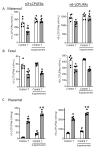Hyperandrogenism diminishes maternal-fetal fatty acid transport by increasing FABP4-mediated placental lipid accumulation†
- PMID: 35357467
- PMCID: PMC9614932
- DOI: 10.1093/biolre/ioac059
Hyperandrogenism diminishes maternal-fetal fatty acid transport by increasing FABP4-mediated placental lipid accumulation†
Abstract
Long-chain polyunsaturated fatty acids (LCPUFAs) are critical for fetal brain development. Infants born to preeclamptic mothers or those born growth restricted due to placental insufficiency have reduced LCPUFA and are at higher risk for developing neurodevelopmental disorders. Since plasma levels of testosterone (T) and fatty acid-binding protein 4 (FABP4) are elevated in preeclampsia, we hypothesized that elevated T induces the expression of FABP4 in the placenta leading to compromised transplacental transport of LCPUFAs. Increased maternal T in pregnant rats significantly decreased n-3 and n-6 LCPUFA levels in maternal and fetal circulation, but increased their placental accumulation. Dietary LCPUFAs supplementation in T dams increased LCPUFA levels in the maternal circulation and further augmented placental storage, while failing to increase fetal levels. The placenta in T dams exhibited increased FABP4 mRNA and protein levels. In vitro, T dose-dependently upregulated FABP4 transcription in trophoblasts. Testosterone stimulated androgen receptor (AR) recruitment to the androgen response element and trans-activated FABP4 promoter activity, both of which were abolished by AR antagonist. Testosterone in pregnant rats and cultured trophoblasts significantly reduced transplacental transport of C14-docosahexaenoic acid (DHA) and increased C14-DHA accumulation in the placenta. Importantly, FABP4 overexpression by itself in pregnant rats and trophoblasts increased transplacental transport of C14-DHA with no significant placental accumulation. Testosterone exposure, in contrast, inhibited this FABP4-mediated effect by promoting C14-DHA placental accumulation.
Keywords: FABP4; androgens; fatty acids; fetal growth; placenta; preeclampsia; pregnancy.
© The Author(s) 2022. Published by Oxford University Press on behalf of Society for the Study of Reproduction. All rights reserved. For permissions, please e-mail: journals.permissions@oup.com.
Figures







Similar articles
-
Increased expression of fatty acid binding protein 4 in preeclamptic Placenta and its relevance to preeclampsia.Placenta. 2016 Mar;39:94-100. doi: 10.1016/j.placenta.2016.01.014. Epub 2016 Jan 19. Placenta. 2016. PMID: 26992681
-
Maternal vitamin D deficiency reduces docosahexaenoic acid, placental growth factor and peroxisome proliferator activated receptor gamma levels in the pup brain in a rat model of preeclampsia.Prostaglandins Leukot Essent Fatty Acids. 2021 Dec;175:102364. doi: 10.1016/j.plefa.2021.102364. Epub 2021 Nov 4. Prostaglandins Leukot Essent Fatty Acids. 2021. PMID: 34768025
-
Maternal dietary fatty acids and their roles in human placental development.Prostaglandins Leukot Essent Fatty Acids. 2020 Apr;155:102080. doi: 10.1016/j.plefa.2020.102080. Epub 2020 Feb 21. Prostaglandins Leukot Essent Fatty Acids. 2020. PMID: 32120190 Review.
-
Alterations in placental long chain polyunsaturated fatty acid metabolism in human intrauterine growth restriction.Clin Sci (Lond). 2018 Mar 15;132(5):595-607. doi: 10.1042/CS20171340. Print 2018 Mar 15. Clin Sci (Lond). 2018. PMID: 29463583
-
Implications of dietary fatty acids during pregnancy on placental, fetal and postnatal development--a review.Placenta. 2002 Apr;23 Suppl A:S9-19. doi: 10.1053/plac.2002.0771. Placenta. 2002. PMID: 11978055 Review.
Cited by
-
ACSM5 inhibits ligamentum flavum hypertrophy by regulating lipid accumulation mediated by FABP4/PPAR signaling pathway.Biol Direct. 2023 Nov 14;18(1):75. doi: 10.1186/s13062-023-00436-z. Biol Direct. 2023. PMID: 37957699 Free PMC article.
-
Elevated gestational testosterone impacts vascular and uteroplacental function.Placenta. 2024 Nov;157:14-20. doi: 10.1016/j.placenta.2023.11.004. Epub 2023 Nov 11. Placenta. 2024. PMID: 37977936 Review.
-
Pathophysiological Insight into Fatty Acid-Binding Protein-4: Multifaced Roles in Reproduction, Pregnancy, and Offspring Health.Int J Mol Sci. 2023 Aug 10;24(16):12655. doi: 10.3390/ijms241612655. Int J Mol Sci. 2023. PMID: 37628833 Free PMC article. Review.
-
Programming of metabolism by adipokines during development.Nat Rev Endocrinol. 2023 Jul;19(7):385-397. doi: 10.1038/s41574-023-00828-1. Epub 2023 Apr 13. Nat Rev Endocrinol. 2023. PMID: 37055548 Review.
-
Single-Cell Analysis of Sex and Gender Differences in the Human Brain During Development and Disease.Cell Mol Neurobiol. 2025 Feb 27;45(1):20. doi: 10.1007/s10571-025-01536-2. Cell Mol Neurobiol. 2025. PMID: 40016536 Free PMC article.
References
-
- Kremmyda LS, Tvrzicka E, Stankova B, Zak A. Fatty acids as biocompounds: their role in human metabolism, health and disease: a review. Part 2: fatty acid physiological roles and applications in human health and disease. Biomed Pap Med Fac Univ Palacky Olomouc Czech Repub 2011; 155:195–218. - PubMed
-
- Innis SM. Perinatal biochemistry and physiology of long-chain polyunsaturated fatty acids. J Pediatr 2003; 143:S1–S8. - PubMed
-
- Haggarty P. Fatty acid supply to the human fetus. Annu Rev Nutr 2010; 30:237–255. - PubMed
-
- Haggarty P. Placental regulation of fatty acid delivery and its effect on fetal growth—a review. Placenta 2002; 23:S28–S38. - PubMed
-
- Dunlop M, Court JM. Lipogenesis in developing human adipose tissue. Early Hum Dev 1978; 2:123–130. - PubMed
Publication types
MeSH terms
Substances
Grants and funding
LinkOut - more resources
Full Text Sources
Research Materials

